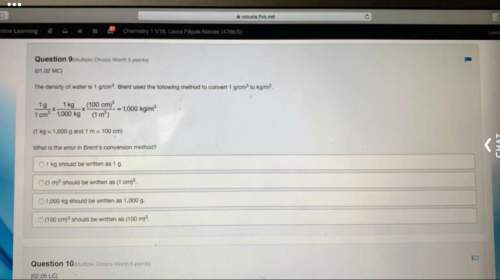
Chemistry, 18.10.2019 23:00 Loggtech24
1. which of the following would be true for the charged particles below (refer to the first image) ? a. the particles in a will affect each other with less force than the particles b. b. the particles in a will affect each other with the same force as the particles in b. c. the particles in a will affect each other with more force than the particles in b. d. the particles in a and b will no be affected by any forces.
2. which of the following is true for the charged particles below (second image)?
a. the particles in a will repel each other and the particles in b will attract each other
b. the particles in a will repel each other and the particles in b will no affect each other.
c. the particles in a will attract each other and the particles in b will not affect each other.
d. the particles in a will attract each other and the particles in b will repel each other.




Answers: 3


Another question on Chemistry

Chemistry, 21.06.2019 22:30
Joseph has hypothesized that sound travels in waves. if he were following the scientific method, what should he do next? a. ask a question. b. test the hypothesis. c. study the results. d. tell other scientists about his hypothesis.
Answers: 1

Chemistry, 21.06.2019 23:00
Matches the chemical name of each oxide of phosphorus to its chemical formula
Answers: 2

Chemistry, 22.06.2019 04:30
Use the drop-down menus to answer each question. which runner finished the 100 m race in the least amount of time? which runner stopped running for a few seconds during the race? at what distance did anastasia overtake chloe in the race?
Answers: 1

Chemistry, 22.06.2019 10:00
The reactions shown here can be combined to make the overall reaction c(s) + h2o(g) ⇌ co(g) + h2(g) by reversing some and/or dividing all the coefficients by a number. a. c(s) + o2(g) → co2(g) k=1.363×10^69 b. 2 h2(g) + o2(g) → 2 h2o(g) k=1.389×10^80 c. 2co(g) + o2 (g) → 2 co2(g) k=1.477×10^90
Answers: 1
You know the right answer?
1. which of the following would be true for the charged particles below (refer to the first image) ?...
Questions


Advanced Placement (AP), 27.07.2019 19:00

Mathematics, 27.07.2019 19:00





History, 27.07.2019 19:00

History, 27.07.2019 19:00


Mathematics, 27.07.2019 19:00


Mathematics, 27.07.2019 19:00

Health, 27.07.2019 19:00

Mathematics, 27.07.2019 19:00

Mathematics, 27.07.2019 19:00


Mathematics, 27.07.2019 19:00


English, 27.07.2019 19:00




